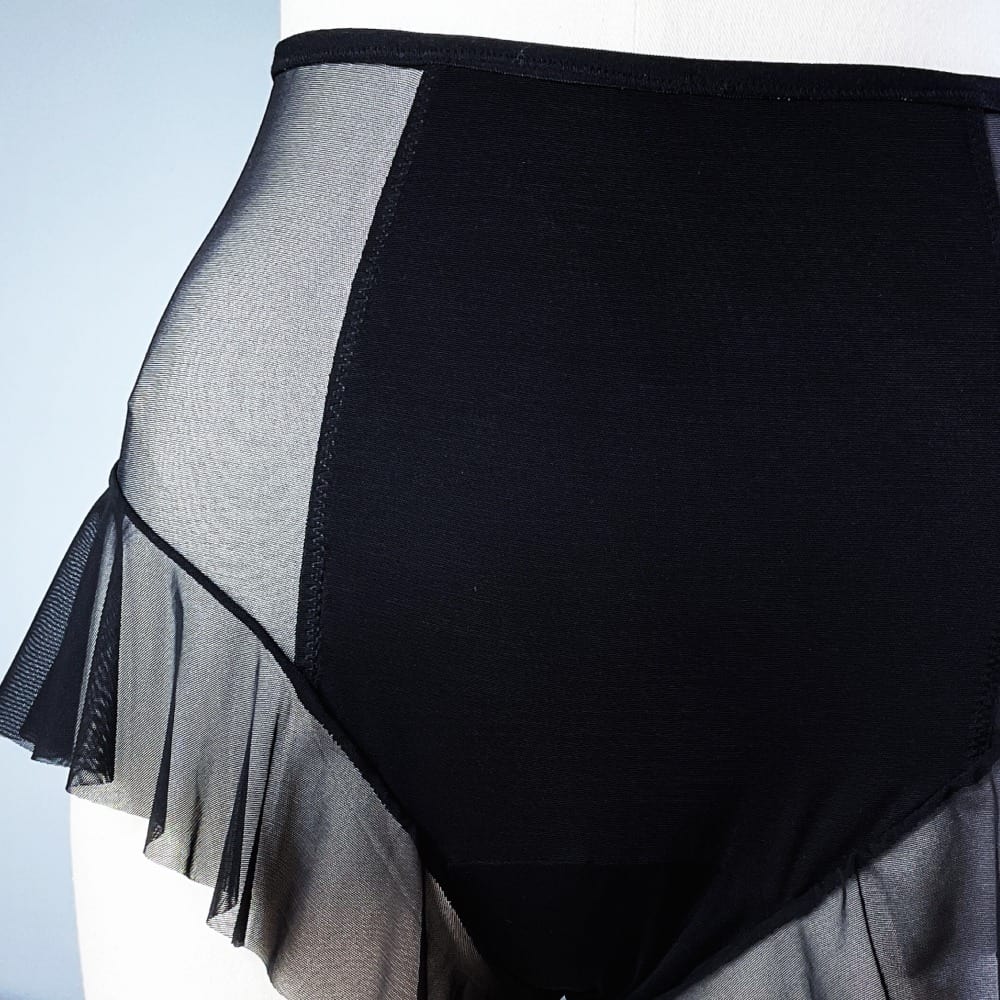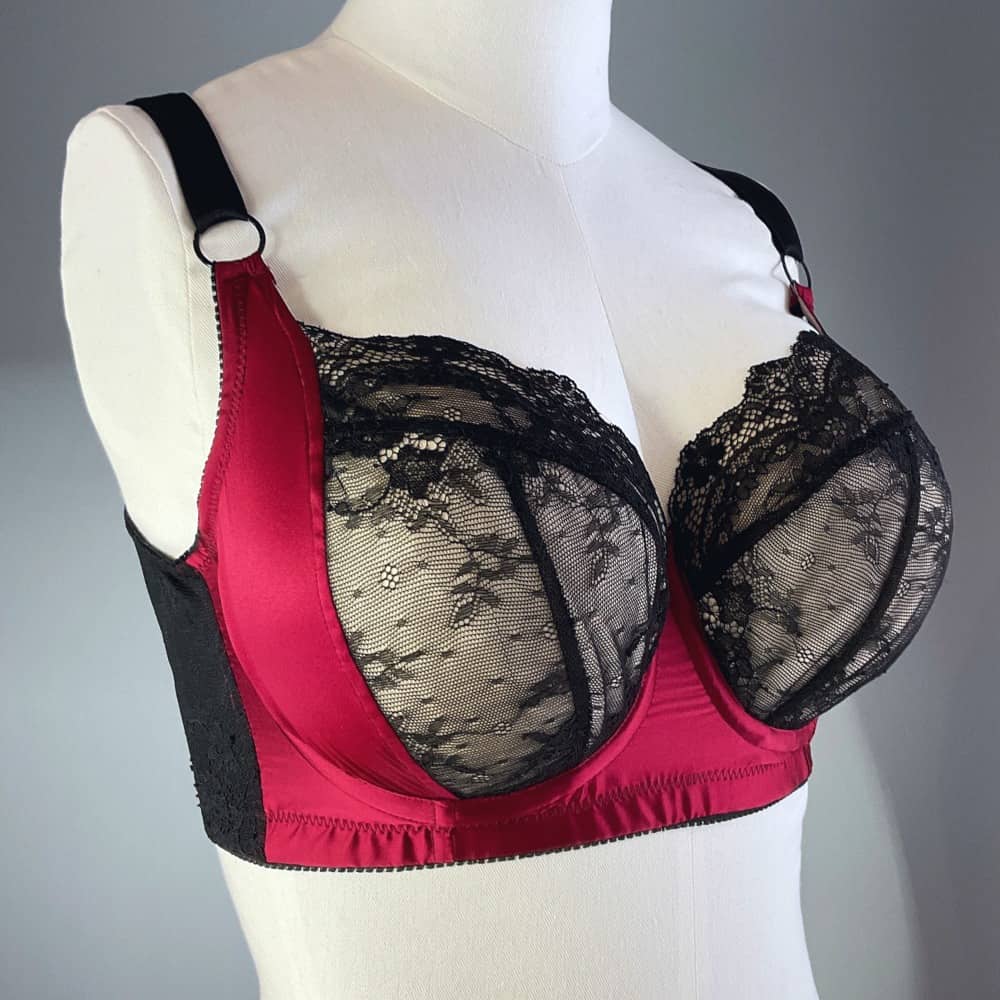Unsure of the difference between sheer cup lining and bra tulle? Not sure which pieces of your bra can use stretch fabric and which should be stable?
Our bra fabrics explainer will guide you through the common fabrics used in lingerie making, so you can start your wonderful adventure on the right path.
The image below shows the the inside of a typical underwired bra. We’ve labelled each part, then underneath we’ll go through the common fabrics used in bra making, what to look out for and suggest where to use them. Don’t forget to always read the recommendations on your chosen pattern. Designers will have a fabric with a particular stretch percentage in mind (or at least a range). If you use a fabric with more or less stretch than the designer intended, this will really alter the fit.

9mm picot or foldover elastic
Back band
powernet
12 or 19mm picot elastic
specific channeling fabric
stable fabric eg sheer cup lining
or bra tulle
stable fabric
eg sheer cup lining
or bra tulle
stretch lace, embroidered tulle,
bra tulle or others;
with sheer cup lining for stability
or comfort as required
Stretch
Non-Stretch
- Stretch Mesh
- Bamboo Jersey
- Powernet
- Stretch Satin
- Stretch Lace
- Embroidered Tulle
- Bra Tulle
- Sheer Cup Lining
- Woven
Stretch 50%
One of the stretchiest fabrics we stock, Stretch Mesh is great for making knickers, bodysuit and bralettes. While we don’t suggest using Stretch Mesh for the back band of a bra instead of Powernet, If you don’t need much support and are making a smaller size and want to use this fabric, you could substitute powernet by using a double layer.
A knitted fabric with stretch in both the horizontal and vertical directions, which is sometimes called two way stretch, but in other countries you may see if being referred to as 4 way stretch.
A super light weight fabric around 65gsm, Stretch Mesh allows for a great range of motion and gives a barely there look to your lingerie. Produced in garment fabric widths Stretch Mesh looks and feels the same on both sides and depending on the manufacturer can have a slight sheen to it.
Try!
This would be a great fabric for the Sophie Hines Altitude thong, the back panel of the Montgomery knickers by Orange Lingerie or the Lawren bodysuite from Madalynne Intimates.

Stretch 50%
Beautifully soft and buttery, Bamboo Jersey is a knitted fabric produced from around 95% bamboo pulp and around 5% elastane. Because of its composition it is and environmentally sustainable fabric which is durable but also thermally regulating, moisture absorbent, Hypo allergenic, breathable and also biodegradable.
Produced in garment fabric widths, Bamboo Jersey has stretch in both the horizontal and vertical directions. The knit structure is visible on the right side as you can see from the close up on the right, and while both sides are extremely soft the wrong side does tend to be slightly smoother. It has a soft drape and comes in various weights, but the Bamboo Jersey we stock is 240gms.
Great for making knickers, the gusset of knickers, sleepwear and camisoles, Bamboo Jersey can be lined to make a great soft bra fabric, or unlined if your pattern calls for a fabric with two way stretch. Always remember to check the stretch percent of your fabric before using it.


40-50% stretch
A very supportive fabric, Powernet is used for the back band of your bra and has great stretch in both directions with a good recovery. The amount of stretch depends on the individual composition, but as an example our Powernet is 20% spandex 80% nylon and has a good firm stretch.
Powernet has a rectangular weave structure. When you stretch the fabric the holes should get smaller, not larger, this is how you can work out your Direction Of Greatest stretch or DOGS. It’s worth getting good quality power net as it has such a technical job to do, after all 90% of your support comes from the band of your bra!
Top tips:
- I like using a double layer, as I love enclosing all my seams. To accommodate the lower % of stretch I get due using two layers, I make sure to increase the length of my band.
- If you are using a stretch lace for the cups or cradle you can also add this over the top of your Powernet for a completely seamless look. Remember to adjust for the 2nd layer.
30-35% stretch
Produced with a satin weave this beautiful fabric includes a small amount of elastane resulting in a high end fabric with the attributes needed to create lingerie garments.
With stretch along the width of the fabric, it’s important to pay attention to any DOGS marked on your pattern pieces. By adding sheer cup lining or bra tulle as a lining you can create a stable fabric with a beautiful luxurious feel to use where you need little to no stretch or on its own for items like knickers, camies or suspender belts.
Stretch Satin is produced in regular fabric widths, usually around 1 meter and has a has a beautiful smooth low sheen finish on the right side and a dull finish on the wrong side. Stretch Satin can come in various weights but the one we stock is 114 gsm and has a lovely soft lightweight drape. Perfect for making matching sets!

Stretch – Variable %
Stretch Lace is just that, a lace which has a stretch to the length and/or width of the fabric. It can come in a variety of widths, so make sure your largest pattern piece fits nicely onto the fabric.
Stretch lace is great on its own for knickers, but doesn’t offer the support needed in most bra sizes, so remember to line it with a stable fabric like sheer cup lining or bra tulle. As long as you stabilise your lace it can be used for both the frame and also the cups of your bra or bralette. Stretch Lace usually has two finished edges, this is called galloon lace, although you can have stretch lace in the larger widths usually associated with other garment fabrics.
Mirrored
Symmetrical
Singular
Stretch 0-5%
Probably one of the most diverse sections embroidered tulle can also include embroidered mesh as well as actual tulle. Rather than a design being weaved or knitted into the fabric the designed is embroidered onto the fabric. As you can imagine the design options are endless.
Embroidered tulles designs fall into three categories, depending on how the design is sewn.
- Mirrored tulle is sold as a pair and the design is produced in two directions, one left facing the other right facing.
- Symmetrical tulle can be used on both edges to create a mirrored effect. The design is the same on both edges.
- Singular direction, often with only one edge finished.
Embroidered tulle doesn’t usually have any stretch, so is great for both the cups and frame of your bra or bralette, but it can also be lined if the fabric is not very soft. Don’t use it for the back band, as that needs to stretch as you breath and move!
If you find your embroidered tulle has more stretch than your pattern suggests, remember to stabilise it with another fabric like sheer cup lining, or your bra won’t fit as it is supposed to.
Usually produced in small widths around 15 to 30cm Embroidered tulle has an obvious right and wrong side, so make sure your are cutting your pattern pieces correctly.
Stretch 0-5%
One of my all time favourite fabrics, but also one that is often mis-sold.
Bra Tulle is a super-fine fabric with a honeycomb structure made from 100% nylon. It has a beautiful lightweight sheer look and the open structure makes it very breathable, great for the Australian climate.
It has very little movement in one direction with slightly more in the other, but when two layers are placed on top of one another at 90°, you get almost no movement. This makes it great for both the cups and frame. As an added bonus you get a beautiful flower pattern, so you know you’ve put the two layers together in the right directions.
Bra Tulle does have a right and wrong side, with one side being slightly softer than the other. Test it out on the back of your hand to check to see which is the right side. While both sides are fine, you might like to put the softer side next to your skin.

single layer vs two layers at 90°


Stretch 0-5%
A sheer, stable fabric with a square weave made of 100% nylon, with little to no movement in either direction. Produced in garment fabric widths, the texture is almost identical on both sides of the fabric, but if you run it against the back of your hands you may notice one side is slightly softer.
Sheer Cup lining can be used for both the frame and cups, however as the name suggests, it’s typically used to line a bras cups and frame when the outer fabric has too much stretch or would not be comfortable on your skin.
A single layer should be enough for most sizes, but if you need more support don’t be afraid to add a double layer.
As this fabric is relatively inexpensive compared to other lingerie fabrics it makes a great go to for both fitting bands and tester cups as well. If your interested in making a fitting band, have a look at the Making a fitting band post.
Sheer Cup lining is also known as stabilised sheer tricot or marquisette mesh depending on the shop, I have seen all these names used interchangeably, but if your not sure what your getting ask for a sample, most online shops would be happy to send out small cut to check for stretch, colour or feel.
Stretch 0-5%
The cups, frame and bridge of your bra can also be made from other fabrics dependent on the pattern and the fabric itself.
While it’s important to check the DOGS of a knit fabric that has stretch, if you want to use a woven fabric such as silk or cotton lawn which doesn’t usually stretch try cutting your pattern pieces on the bias.
Woven fabric isn’t designed to be used for underwear, with all its curves, so you might get flat spots due to the rigid nature of the fabric and the fit comes up smaller as it doesn’t mold like a knit fabric.
Unlike garment sewing, lingerie has very small pattern pieces and you can often raid your scrap bin to use up your leftover fabric. The bra to the right is made from leftover Liberty Tana Lawn from one of my favorite fabric shops here in Perth, Calico and Ivy.

Cut Fabric
One unit in our shop equates to:
- Laces and embroidered tulles – 1/2 metre length
- Mirrored tulles – 1/2 metre of left & 1/2 metre of right facing tulle
- Powernet, Stretch Satin, Bra Tulle, Sheer Cup Lining, Stretch Mesh & Bamboo Jersey are all cut as a fat quarter. This is 1/2 metre lengthwise and half the total width of the fabric (see individual fabric for specific width)
- Elastics – 1 metre length


